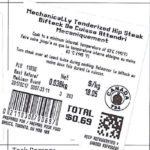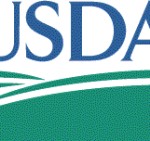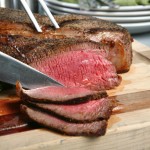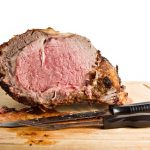With grilling season upon us and the Fourth of July holiday next week, most Americans are taking to their outdoor grills. We grill everything from chicken wings to veggies to burgers to steaks. But do you know if you are grilling mechanically tenderized beef? There are several ways of tenderizing meat: marinating, the way you cut it after it's cooked, and mechanical tenderizing. Knowing if the meat you are grilling is mechanically tenderized can make the difference between enjoying a nice meal and getting sick. And there's a lot of mechanically tenderized beef out there: 6.2 billion servings of mechanically tenderized beef are served every year on American tables. The USDA is offering tips on how to protect yourself and your family while grilling. One section of that piece … [Read more...]
Mechanically Tenderized Steak Recalled for E. coli O157:H7
The Canadian Food Inspection Agency and Vantage Foods are recalling some mechanically tenderized steak for possible E. coli O157:H7 contamination. This type of steak has been injected with needles or blades to break up connective tissue, or has been injected with a marinade or tenderizer. This action can force pathogenic bacteria from the surface of the steak to the interior. No illnesses have been reported to date in connection with this issue. The recalled products are Food Basics brand name. They are Mechanically Tenderized Hip Steak in variable sizes, with best before 2017OC17 and UPC number starting with 0 211030. The other recalled products is Mechanically Tenderized Steak FP in variable sizes, with best before 2017OC17 and UPC number starting with 0 224015. These steaks were sold … [Read more...]
New Labels and Instructions for Mechanically Tenderized Beef
The USDA's Food Safety and Inspection Service is unveiling their new labeling and cooking requirements for mechanically tenderized beef. Starting this week, meat processors are required to tell consumers if the steak or roast they are buying has been tenderized with blades or needles. This process can push pathogenic bacteria such as E. coli and Salmonella from the surface of the meat into the interior. Then, if the cut is cooked to a temperature of rare, bacteria that cause illness can survive and make people sick. The final rule establishing the label identification was published on May 18, 2015. The product name for these products must contain this description: "Mechanically Tenderized" or, if needle tenderized the product can be described as "Needle Tenderized," or if blade … [Read more...]
USDA Finally Finalizes Mechanically Tenderized Beef Label Rule
The USDA has finally finalized labeling requirements for mechanically tenderized beef. That product is pierced with needles or small blades to tenderize, which introduces bacteria into the interior. When the beef is cooked less than well done, people who eat it can get sick because bacteria survive at temperatures less than 160°F. The rule will go into effect in May 2016, one year from the date of the rule's publication in the Federal Register. USDA Deputy Under Secretary for Food Safety Al Almanza said in a statement, "labeling mechanically tenderized beef products and including cooking instructions on the package are important steps in helping consumers to safely prepare these products. This common sense change will lead to safer meals and fewer foodborne illnesses." There have been … [Read more...]
Vilsack Commits to Exempting Mechanically Tenderized Beef Regulation
According to Congresswoman Rosa DeLauro (D-CT), USDA Secretary Tom Vilsack said last week in a congressional hearing that he may suspend the Uniform Labeling Regulation so that the rule for labeling mechanically tenderized beef (MTB) products can be issued. Mechanically tenderized beef is whole cuts of beef that have been pierced with fine blades or needles to break up the connective tissue in the meat. This action introduces bacteria to the interior of the cut, and poses a food safety hazard if the meat is not cooked to 160°F. The MTB labeling rule has been pending for 10 years. Meanwhile, there have been food poisoning outbreaks linked to this product. Two outbreaks, one in 2003 and the other in 2009, caused 174 illnesses and killed one person. And remember that these numbers are only … [Read more...]
Rep. DeLauro Urges OMB to Finalize Mechanically Tenderized Beef Rule
Representative Rosa DeLauro (D-CT) wrote to Shaun Donovan, director of the Office of Management and Budget this week, urging him to finalize the new USDA rule on mechanically tenderized beef products. There may be a delay implementing this critical rule if it is not finalized by December 31, 2014. Mechanically tenderized beef has been pierced with blades or needles to break up connective tissue so the meat is more tender. Unfortunately, this process pushes pathogenic bacteria present on the surface of the cut into the interior. Then, if the meat is cooked less than well-done, those bacteria survive in the center of the product, and can make someone sick. A 2008 study by USDA states that about 50,000,000 pounds of this product are sold every month without labels warning consumers of … [Read more...]
Coalition Asks Vilsack to Finalize Mechanically Tenderized Beef Label
The Safe Food Coalition has sent a letter to Agriculture Secretary Tom Vilsack, urging him to finalize the mechanically tenderized beef label and send it to the Office of Management and Budget for final approved. The USDA has delayed finalizing this rule that has been "in process" since 2008. Canada has already mandated a label for these products, which are whole cuts of beef, including steaks, pierced with needles or pins to tenderize them. This action forces pathogenic bacteria from the surface of the meat into the interior. If the tenderized beef is not cooked to 160°F, or well done, those bacteria can survive and make someone sick. A 2012 E. coli O157:H7 outbreak linked to XL Foods recalled mechanically tenderized beef in Canada prompted this change in that country. The treated … [Read more...]
Canada Mandates Labeling Mechanically Tenderized Beef
The government of Canada is mandating labeling of mechanically tenderized beef. All MTB products sold in Canada must be clearly labeled as "mechanically tenderized" and include instructions for safe cooking. These products have been tenderized by piercing with needles or blades. This process introduces bacteria into the center of the cut of meat, and means the meat is not safe to consume unless it is cooked well done. Several outbreaks in both Canada and the United States have been linked to undercooked mechanically tenderized beef. An E. coli O157:H7 outbreak in Canada in 2012 was linked to mechanically tenderized beef produced by XL Foods; at least 10 people were sickened. In the United States, there were at least five outbreaks of E. coli O157:H7 linked to mechanically tenderized … [Read more...]
AMI Wants FSIS to Withdraw Mechanically Tenderized Meat Rule
The American Meat Institute has commented on FSIS's proposed new rule to label mechanically tenderized beef, stating that they are opposed to labeling because "the food safety risk associated with mechanically tenderized beef products is very low and does not warrant the proposed labeling." Consumer Reports states that there have been at least five outbreaks of E. coli O157:H7 linked to mechanically tenderized beef between 2003 and 2009, causing at least 174 illnesses and killing one person. And since those cases are drastically underreported, making the multiplier for E. coli as large as 27, that means 4,698 people may have been sickened in those outbreaks. And last year, there was an E. coli O157:H7 outbreak in Canada linked to mechanically tenderized steak that sickened 18 people. In … [Read more...]
FSIS Extends Comment Period for Labeling Mechanically Tenderized Beef
Last Friday, the USDA's Food Safety and Inspection Service extended the comment period for its proposed rule requiring labeling for mechanically tenderized beef. Those products are processed with needles or fine blades to break up the meat fibers and make the steak more tender. The rule also applies to beef products that are injected with a marinade. But those processes push pathogenic bacteria on the surface of the beef into the center. Then when the meat is cooked less than well-done, those bacteria are not destroyed and people can get sick. The rule was proposed on June 10, 2013, and the comment period has been extended to October 3, 2013. The original comment deadline was in August 2013. Apparently, two trade associations asked FSIS to extend the rule an additional 120 days, but … [Read more...]









